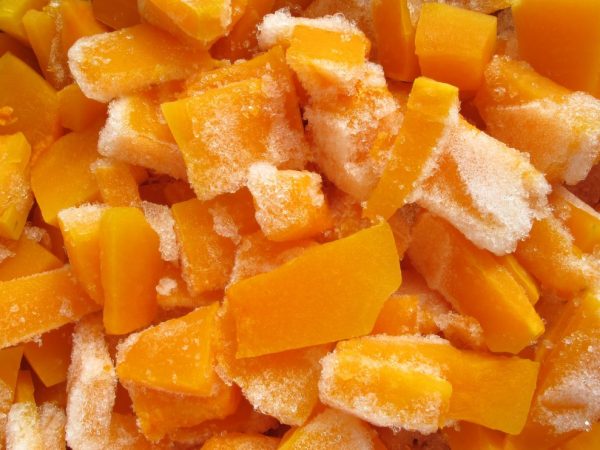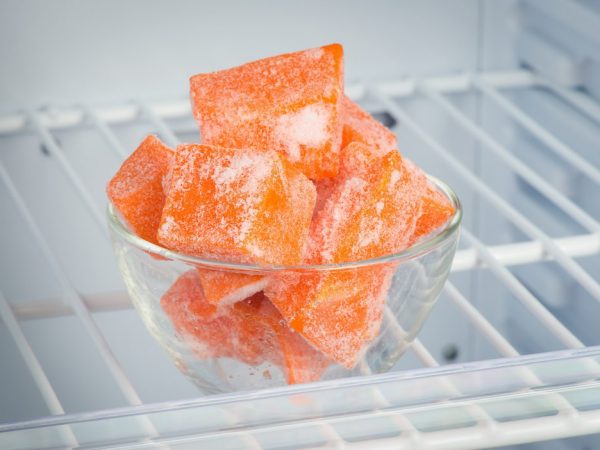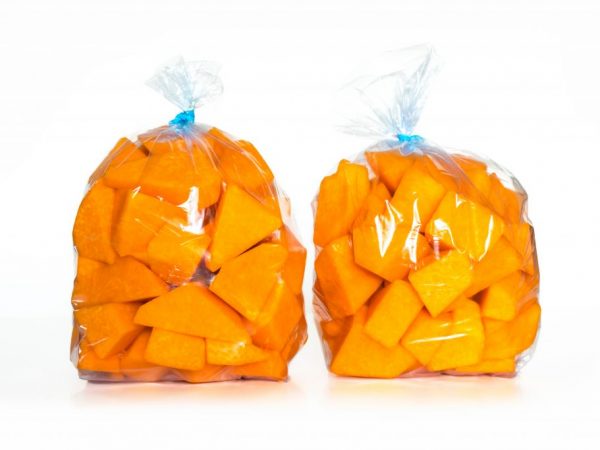Freezing pumpkin methods
Freezing pumpkin is an effective way to preserve a vegetable for the winter with minimal loss of valuable substances. Most of the vitamins (with the exception of vitamin C) remain in their original form.

Freezing pumpkin methods
Training
Only fresh pumpkin is suitable for freezing, preferably straight from the garden. Stay and spoiled vegetables should not be frozen.
The pumpkin must be washed, cut and peeled. Also, seeds are removed from it along with the slippery inside. As a result, one pulp should remain.
The pumpkin can be frozen raw or blanched. In the latter case, after defrosting, it will be almost cooked, but less vitamins will remain in it. Also, the vegetable can be boiled or baked in the oven.
Cooking helps to partially rid the purchased fruits of nitrates.
Freezing methods
In one piece
The easiest way is to put the whole pumpkin in the freezer, and if it is large, divide it up.
After defrosting, the vegetable must be used in one go - re-freezing is undesirable.
Before sending a piece to the freezer, put it in a vacuum bag or wrap it tightly with cling film.
If desired, such a workpiece is pre-blanched (with hot steam or dipped in boiling water for a couple of minutes).
After that, it is dipped in cold water, and then laid on a towel and allowed to dry well.
You should not rinse the workpieces under the tap, as they lose many valuable substances in running water.
Cubes
If you freeze the pumpkin in pieces, it will be very convenient to use it for dishes in which the vegetable must keep its neat shape (for soup, stews, salads, fillings, etc.).
You can cut vegetables in any way - strips, rectangles, etc. (However, it is believed that the shape of the cube is better preserved when boiling or stewing).

Freezing in cubes is most convenient
First, they are frozen for a couple of hours on a tray or board. Then they are collected from the board and transferred to a bag or container and finally sent to the freezer. This will prevent them from sticking together during storage.
Shavings
Pumpkin shavings are very useful for making pancakes, muffins and pancakes. With its help, a variety of fillings for pies, rolls, dumplings, etc. are prepared. In addition, it is also used for main dishes - it is added to soup, stews, cereals, sauces, meat, vegetable purees.
The pumpkin, cut into several pieces, is rubbed and squeezed a little juice.
The shavings should be packaged in small sachets, each serving for a single use. By distributing it in an even layer, a compact workpiece is obtained, which will not take up extra space in the freezer.
Puree
When freezing pumpkin for the winter in the form of mashed potatoes, you can save space in the refrigerator, store homemade preparations in different ways: in bags, in cups, in a container, etc.
You can make mashed potatoes from boiled or baked vegetables. According to the reviews of those who cook, the dish from the baked pumpkin turns out to be tastier and sweeter.
The pumpkin pulp, cut into pieces, is boiled for several minutes or laid out on a baking sheet and placed in the oven - until tender. (Cooking time depends on the size and thickness of the piece.)
The finished product is mashed or chopped using a blender. The resulting mass is cooled, packed and placed in a freezer.
Defrost and cook
If you freeze the pumpkin correctly, then its beneficial properties and appearance will remain unchanged.
But do not forget about the features of defrosting. This is an important point.
It is better to defrost the workpieces gradually. First, put them out of the freezer and put them in the refrigerator overnight.
If there is not much time, defrost the vegetable not in the refrigerator, but right on the table, or put a bag with the product in warm water.
Cubes or shavings intended for a hot meal (soup, gravy, vegetable stew, etc.) can be used immediately.
They are added to the pan frozen and the pieces of vegetables "reach" during the cooking process.
It is convenient to defrost mashed potatoes in the microwave, getting a ready-made dish or adding the necessary ingredients (sugar, milk, etc.) to it.
Additional Tips

It is advisable to consume frozen vegetables within six months.
Recommendations for freezing pumpkin at home.
- If your freezer has a shock freeze function, be sure to use it. When frozen quickly, the vegetable fully retains its beneficial properties and loses them much more slowly over time.
- The product can be stored in the freezer for a long time - even several years. However, such storage does not make much sense, since frozen vegetables also lose their valuable substances, although not as quickly as fresh ones. The optimal shelf life of frozen melons at home is no more than 6 months.
- Sliced pumpkin pulp can be frozen in combination with other vegetables - carrots, zucchini, broccoli. By defrosting such a blank, you will receive all the ingredients for a healthy vegetable puree.
- It is convenient to freeze pumpkin puree in ice cube trays or silicone bakeware. When it freezes, it is taken out of the mold and placed in a bag or container.
- You can bake pumpkin slices in the oven for mashed potatoes with the peel. When the vegetable is ready, the pulp is simply scraped out of the skin with an iron spoon and ground into mashed potatoes.
- When freezing pumpkin pieces in a container, it is important to keep in mind that they will soon expand slightly. If you fill the container "to the eyeballs" - it can burst. Leave one centimeter free to the top to prevent damage to the workpiece.
- If the vegetable is too juicy, it is better to dry it slightly before sending it to the freezer, otherwise the pulp will turn out to be watery after defrosting. You can dry the pieces simply in the air or in the oven (at a minimum temperature and a slightly open door).
- Never use unripe or overripe vegetables for freezing. An unripe pumpkin will not be beneficial and can disrupt digestion, and the taste and quality of an overripe pumpkin leaves much to be desired.
- A healthy vitamin drink can be made from pumpkin chips or boiled vegetables. To do this, they are thawed and ground in a blender, after which orange juice is added (in a 1: 1 ratio). The shavings can also be squeezed through cheesecloth and mixed with honey and lemon juice (to taste).
Conclusion
Frozen pumpkin retains valuable trace elements and vitamins for a long time. The form and method of freezing depends on the dishes you are going to cook. Having spent a little time on the preparation of frozen pumpkin in the fall, you will get a tasty and healthy product that diversifies the winter menu, which is poor in vitamins.

